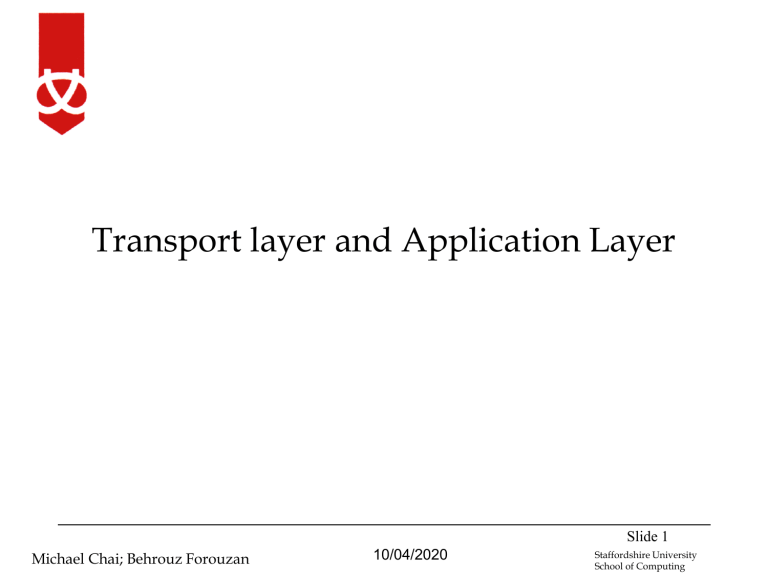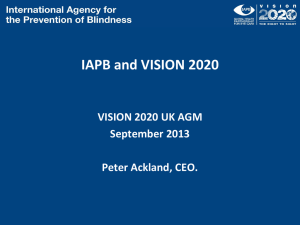UDP, TCP, DNS, FTP and SNMP

Transport layer and Application Layer
Michael Chai; Behrouz Forouzan 10/04/2020
Slide 1
Staffordshire University
School of Computing
IADCN - Week 5
Addressing and Protocols
Port Address
Logical Address
Physical Address
Application Layer
DNS, FTP,TFTP, SNMP,
HTTP
Transport Layer
Network Layer
Physical and Data
Link Layers
SCTP, TCP, UDP
ICMP, IGMP, ARP, RARP
Michael Chai; Behrouz Forouzan 10/04/2020 Staffordshire University
School of Computing
IADCN - Week 5
Michael Chai; Behrouz Forouzan 10/04/2020 Staffordshire University
School of Computing
IADCN - Week 5
Transport Layer
Port Address
Logical Address
Physical Address
Application Layer
DNS, FTP,TFTP, SNMP,
HTTP
Transport Layer
Network Layer
Physical and Data
Link Layers
SCTP, TCP, UDP
ICMP, IGMP, ARP, RARP
Michael Chai; Behrouz Forouzan 10/04/2020 Staffordshire University
School of Computing
IADCN - Week 5
Transport Layer
Starts and stops the connection of the transmission.
– At the transmitter, it is responsible for chopping the stream of data into transportable datagrams, numbering them and then sending them one by one.
– At the receiver, it is responsible for waiting until all datagrams have arrived, checking for errors and then processing as a stream.
Provides connection mechanism between two or more running application programs.
– Transmission control protocol (TCP) with flow control
– User datagram protocol (UDP) with no flow control
Michael Chai; Behrouz Forouzan 10/04/2020 Staffordshire University
School of Computing
IADCN - Week 5
Transport Layer
Michael Chai; Behrouz Forouzan
Domain of Transport Protocol
10/04/2020 Staffordshire University
School of Computing
IADCN - Week 5
IP address versus Port address
Michael Chai; Behrouz Forouzan 10/04/2020 Staffordshire University
School of Computing
IADCN - Week 5
Socket Address
Michael Chai; Behrouz Forouzan 10/04/2020 Staffordshire University
School of Computing
IADCN - Week 5
User Datagram Protocol (UDP)
Simple protocol and limited overhead as compared to
IP packet.
No additional services added into the IP packet, apart from starting and stopping the connection.
Connectionless and “unreliable” transport protocol.
Independent datagram - not numbered
Suitable for simple request-response communication
(Refer to the port number table for more info)
Michael Chai; Behrouz Forouzan 10/04/2020 Staffordshire University
School of Computing
IADCN - Week 5
UDP Port addresses
Michael Chai; Behrouz Forouzan 10/04/2020 Staffordshire University
School of Computing
IADCN - Week 5
TCP – Handling many connections
The addition of connect instance id codes makes multiple simultaneous connections possible.
Michael Chai; Behrouz Forouzan 10/04/2020 Staffordshire University
School of Computing
IADCN - Week 5
Transmission Control Protocol (TCP)
Connection-oriented protocol and reliable transport protocol.
Create a virtual connection between two application programs to send data.
Virtual connection – connected as in the transport layer
Michael Chai; Behrouz Forouzan 10/04/2020 Staffordshire University
School of Computing
IADCN - Week 5
Michael Chai; Behrouz Forouzan 10/04/2020 Staffordshire University
School of Computing
IADCN - Week 5
TCP Ports
Michael Chai; Behrouz Forouzan 10/04/2020 Staffordshire University
School of Computing
IADCN - Week 5
Application Layer
Port Address
Logical Address
Physical Address
Application Layer
DNS, FTP,TFTP, SNMP,
HTTP
Transport Layer
Network Layer
Physical and Data
Link Layers
SCTP, TCP, UDP
ICMP, IGMP, ARP, RARP
Michael Chai; Behrouz Forouzan 10/04/2020 Staffordshire University
School of Computing
IADCN - Week 5
Domain Name System (DNS)
Each terminal in network has an unique IP address and a name (name space).
A name space maps IP address to a unique name in either flat or hierarchical method.
DNS is used for designing hierarchical name space
– Example of hierarchical name space: www.staffs.ac.uk
, www.fcet.staffs.ac.uk
, gawains.staffs.ac.uk, blackboard.staffs.ac.uk
Maximum of 128 levels with maximum 63 characters in each node of the tree.
Michael Chai; Behrouz Forouzan 10/04/2020 Staffordshire University
School of Computing
IADCN - Week 5
DNS
Michael Chai; Behrouz Forouzan 10/04/2020 Staffordshire University
School of Computing
IADCN - Week 5
Domains
Michael Chai; Behrouz Forouzan 10/04/2020 Staffordshire University
School of Computing
IADCN - Week 5
Domain Name and Label
Michael Chai; Behrouz Forouzan 10/04/2020 Staffordshire University
School of Computing
IADCN - Week 5
DNS Server
Stores domain name space information within its domain/sub-domain.
Michael Chai; Behrouz Forouzan 10/04/2020 Staffordshire University
School of Computing
IADCN - Week 5
File Transfer Protocol
Standard protocol for copying a file from one host to another.
It standardises the data format and structure.
Uses two TCP connections
– Port 21 for control connection
– Port 20 for data connection
Trivial File Transfer Protocol (TFTP) is used in simple and quickly copy file protocol that uses the
UDP services.
Michael Chai; Behrouz Forouzan 10/04/2020 Staffordshire University
School of Computing
IADCN - Week 5
FTP
Michael Chai; Behrouz Forouzan 10/04/2020 Staffordshire University
School of Computing
IADCN - Week 5
FTP Mechanism
Michael Chai; Behrouz Forouzan 10/04/2020 Staffordshire University
School of Computing
IADCN - Week 5
Simple Network Management Protocol (SNMP)
A framework for managing devices in network using
TCP/IP protocol suite.
– Manager – SNMP client program installed in the server
– Agent – SNMP server program installed in the router or host
The SNMP client program can perform actions for monitoring and maintaining the performance of the network.
uses UDP services at port 161 and 162 for agent and manager respectively.
Michael Chai; Behrouz Forouzan 10/04/2020 Staffordshire University
School of Computing
IADCN - Week 5
Conclusion
We have discussed the major protocols in transport and application layers of TCP/IP protocol suite.
TCP and UDP are used for the connection mechanism between two or more running application programs.
The application layer components such as DNS, FTP,
TFTP and SNMP are the major components for networking programming.
Other components discussed in the previous week were Javascript, ASP script and Applet.
Michael Chai; Behrouz Forouzan 10/04/2020
Slide 25
Staffordshire University
School of Computing










